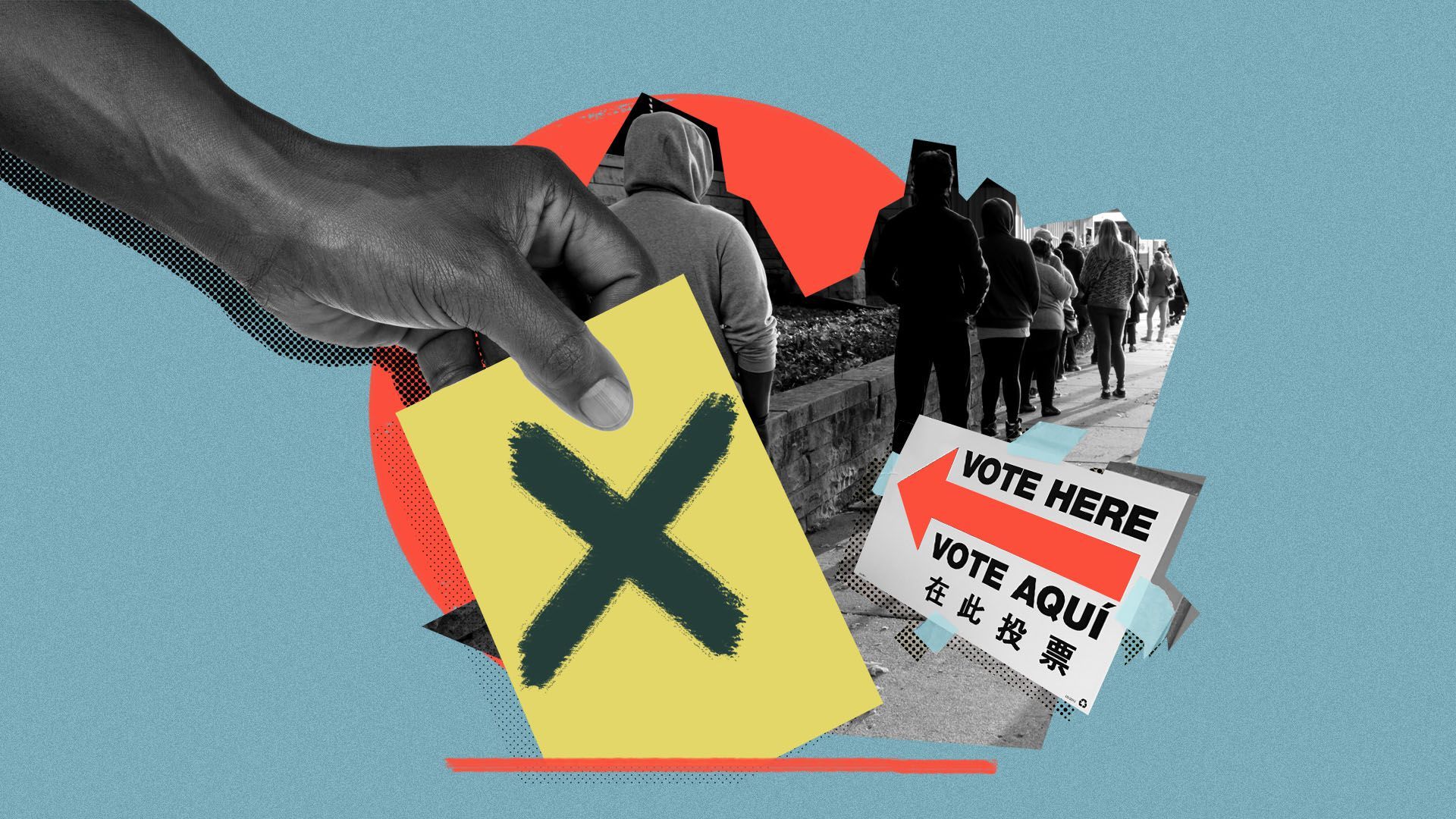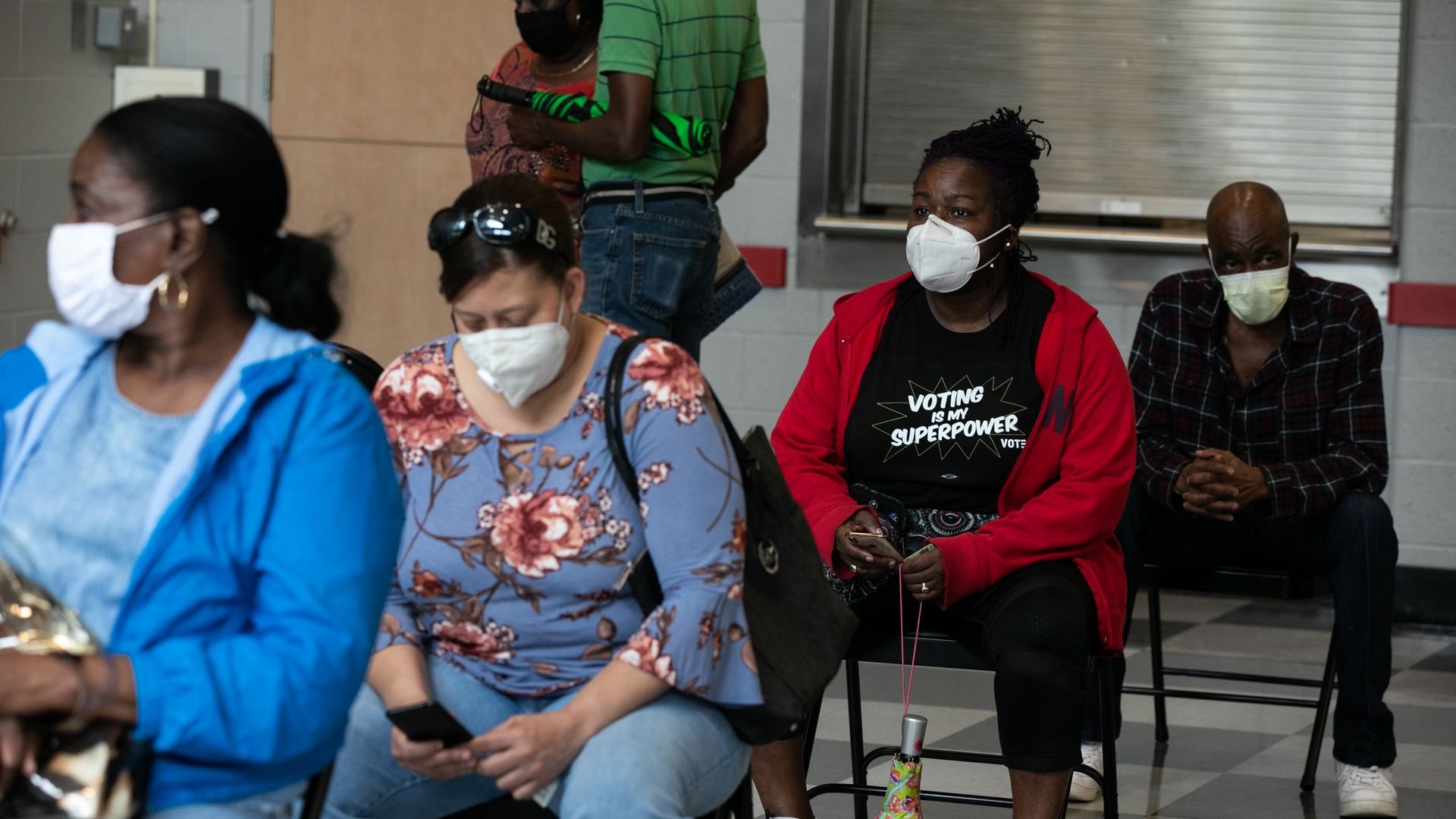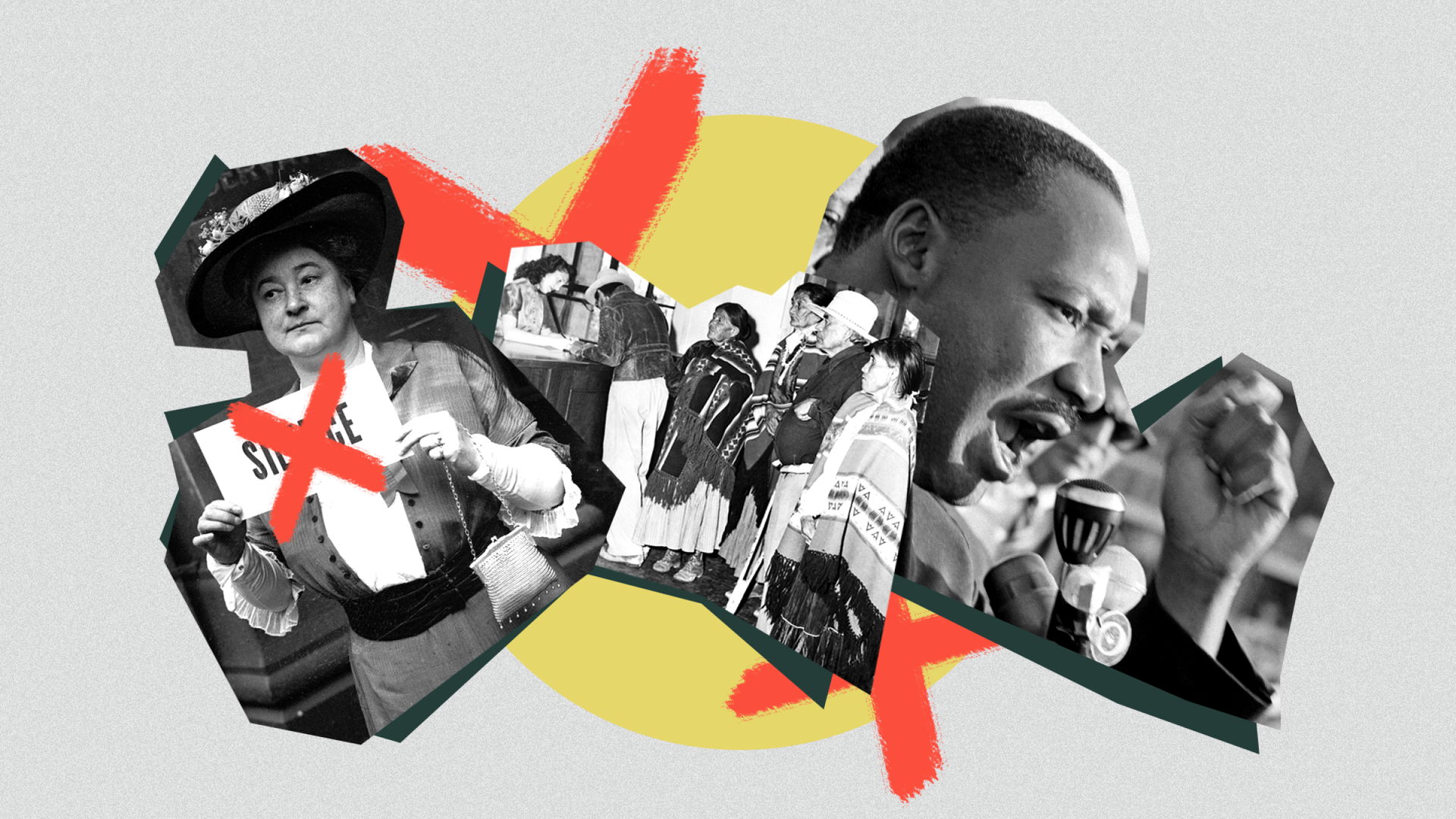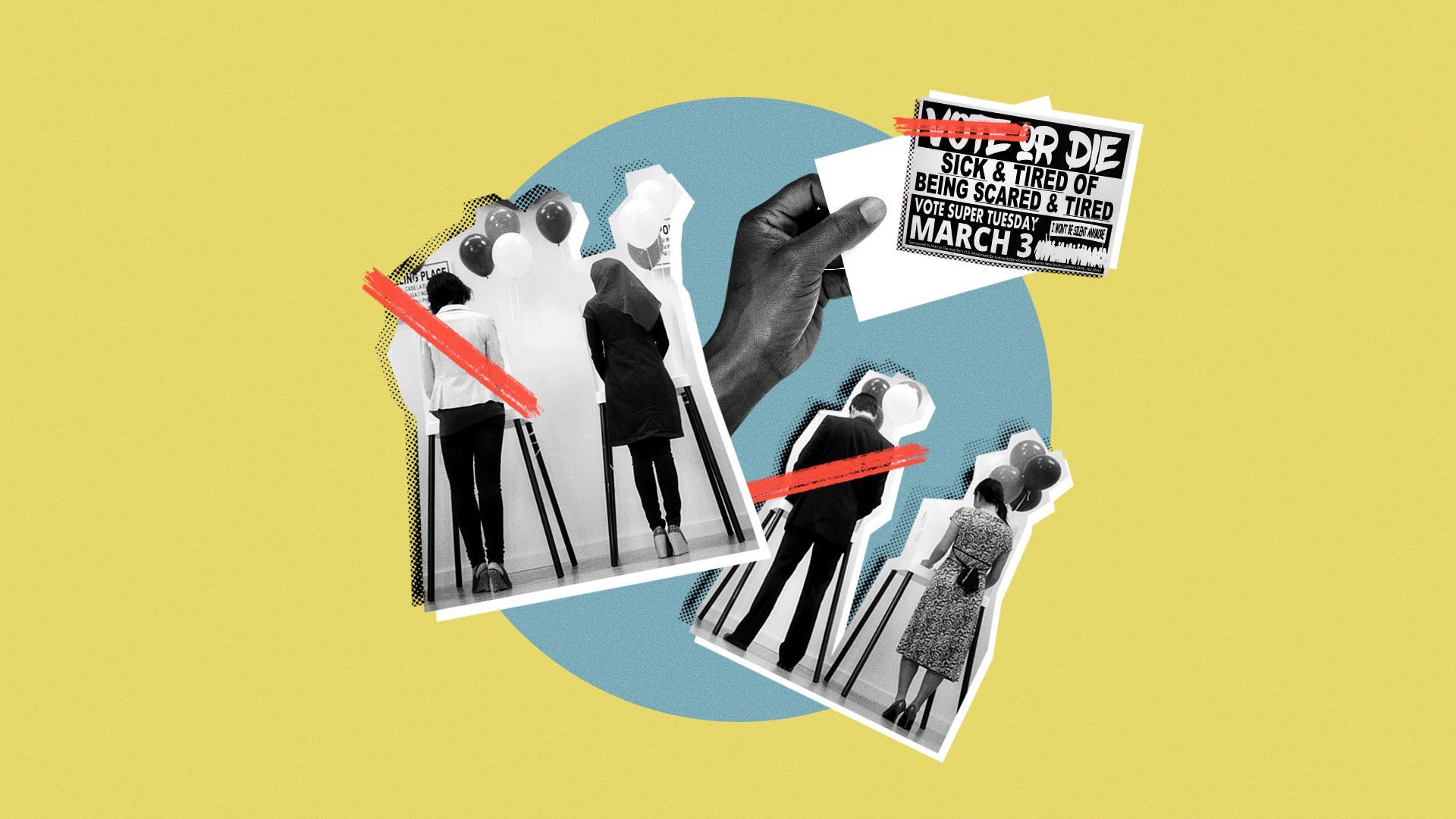| | | | | | | Presented By Snapchat | | | | Axios AM Deep Dive: | | Hard Truths | | By Mike Allen ·Oct 17, 2020 | | View in browser | | Good afternoon and welcome to the first of our Hard Truths Deep Dives examining systemic racism in America. - Less than three weeks before the election, we're focused on voting, led by White House and Politics Editor Margaret Talev.
Join Axios on Tuesday at 12:30 p.m. ET for the first Hard Truths event in a yearlong series. We're kicking off with a discussion on voting rights. Register here. 🎧Listen to a special edition of the "Axios Today" podcast on vote suppression. Today's Smart Brevity™ count: 1,483 a 5 1/2-minute read. | | | | | | 1 big thing: The truth about racism and voting |  | | | Photo illustration: Sarah Grillo/Axios. Photos: Jeremy Hogan/SOPA Image, Noam Galai/WireImage via Getty Images | | | | Laws restricting voting are less overt than in the days of segregation. But many impediments — some subtle, some blatant — remain for Americans of color. The big picture: That's changing at this very moment — slowly, and very unevenly, Axios Executive Editor Sara Kehaulani Goo and White House and Politics Editor Margaret Talev report. - Some barriers are being lowered — partly in an effort to make voting safer in the pandemic, and partly because of awareness brought about by this summer's racial-justice demonstrations.
- In some red states, though, officials are actually trying to restrict voting further.
Why it matters: Demographic tides are changing what America looks like. The more people vote, the more our public life will reflect those changes. Between the lines: Joe Biden has leaned into these trends — by naming the first woman of color as his running mate, by promising that his first choice for the Supreme Court will be the first Black woman to be nominated, and by making plans for the most diverse Cabinet in U.S. history. Modern voter suppression is achieved through practices like polling place closures, vote-by-mail restrictions, erroneous voter roll purges and overly burdensome voter ID requirements. - Be smart: Here are the facts about voter fraud, mail-in and early voting, how racial politics still shape laws — and why voters of all races and partisan leanings should care.
Actual instances of voter fraud are extraordinarily rare: - President Trump's Election Integrity Commission found no evidence of voter fraud and disbanded.
- FBI Director Christopher Wray testified last month that his agency had "not seen, historically, any kind of coordinated national voter fraud effort in a major election, whether it's by mail or otherwise."
- Federal courts don't buy it: Judges have dismissed lawsuits in several states where the Trump campaign and the RNC have challenged mail-in ballots on grounds that voter fraud might occur.
- A 2017 Brennan Center report examined 42 jurisdictions in the 2016 election and found voter fraud "exceedingly rare." Of 23.5 million votes examined, election officials found 30 incidents (0.0001% of votes cast).
Don't forget: U.S. elections are run by states. That empowers some to push restrictions that disproportionately affect people of color, said Wilfred Codrington III, a Brooklyn Law School professor and Brennan Center fellow. So how much access you have to democracy is "totally dependent on where you live." - In several states — from Texas to Montana — judges have rejected laws on voter restrictions, finding they intentionally targeted Hispanics, Black Americans and Native Americans.
- Other states have linked criminal records to one's right to vote, disproportionately disenfranchising millions of Black men who have served their time.
- Historic barriers to voting are one reason why voter turnout among non-white Americans has historically been much lower than among white people, although recent elections may reverse that trend.
What's next: The pandemic has made everyone more aware of the limitations and possibilities around modern-day voting. - As the nation becomes more diverse, who constitutes the majority and who controls political power are changing. Laws that promote fairness and access while protecting ballot security serve all Americans in the long run.
|     | | | | | | Bonus images: The wait to vote |  | | | Photo: Jessica McGowan/Getty Images | | | | Above: People in Atlanta wait to cast ballots on the first day of early voting, Oct. 12. Below: Voters in cars line up at a drive-through mail ballot drop-off site in Houston on Oct. 7, after Texas Gov. Greg Abbott issued an executive order limiting each county to one ballot drop-off site. Photo: Go Nakamura/Getty Images |     | | | | | | 2. A history of voter exclusion |  | | | Photo illustration: Sarah Grillo. Photos: Bettmann, Chicago History Museum/Getty Images | | |  Graphic: Sarah Grillo, Naema Ahmed/Axios. Photos: Bettmann, Chicago History Museum/Getty Images |     | | | | | | A message from Snapchat | | In the wake of COVID-19, Gen Z is more excited than ever to vote | | |  | | | 82% of Gen Zers say COVID-19 has made them realize how their political leaders' decisions impact their everyday lives. Snapchat is helping young voters get to the polls by providing in-app resources that help them: - Register.
- Find their polling place.
- Learn their sample ballot and voting options.
| | | | | | 3. Voter suppression then and now |  | | | Photo illustration: Eniola Odetunde/Axios. Photo: Barry Lewis/Getty Images | | | | From its start, the United States gave citizens the right to vote — as long as they were white men who owned property. Since counting a slave as 3/5 of a white man, and the creation of the Electoral College, there's a through-line of barriers that extends to today based on racial politics, Axios' Fadel Allassan reports. Why it matters: 150 years after the 15th Amendment — and 55 years after passage of the Voting Rights Act — people of color still face systemic obstacles to voting. The state of play: The Supreme Court's 2013 ruling in Shelby County v. Holder gutted the enforcement provision of the Voting Rights Act, unleashing a slew of new state laws to make voting more difficult. - Voter purges: New York, Florida, Virginia and North Carolina conducted illegal voter purges resulting in millions of registered voters being erroneously removed, per the Brennan Center.
- Closed polling places: A 2016 examination of 381 counties in the South found 43% had reduced polling locations. A USA Today analysis found states closed thousands of polling places in 2016, the majority in Black or Hispanic communities.
- Voter ID laws: 36 states want voters to show a form of ID at the polls. North Carolina passed strict voter ID and other early-voting restrictions that a federal appeals court in 2016 found "target African Americans with almost surgical precision." In 2017, a federal judge ruled that a Texas voter ID law was passed to discriminate against the state's Hispanic and Black voters.
- Voting fees: In Florida, voters overwhelmingly passed a measure in 2018 to reinstate voting rights to felons who had served their time — only for state lawmakers to pass a law requiring such felons to first pay fines averaging $1,000. A lower court ruled the fees amount to a modern-day poll tax — but the law was upheld by a federal appeals court.
- Language barriers: In 2014, a federal court ruled that Alaska broke the law by failing to provide ballots in appropriate languages to Alaska Native tribes.
- Elusive ballots: In Montana, a state court last month struck down a law that set arbitrary limits on the number of people who can collect ballots on tribal land, saying it was overly burdensome for the state's Native American voters.
The bottom line: Requiring ID to vote or updating voter rolls isn't necessarily discriminatory. But implementation matters, and together they disproportionately affect non-white voters. |     | | | | | | Bonus: Axios-Ipsos Race and Voting Poll |  Data: Axios/Ipsos poll; Note: ±2.6% margin of error; Chart: Naema Ahmed/Axios Go deeper. |     | | | | | | 4. Incarceration and voting rights |  Data: The Sentencing Project; Map: Andrew Witherspoon/Axios A movement to restore voting rights to felons who've served their time is shifting voting participation — and the implications are fueling resistance. The big picture: Mass incarceration has elevated Black voter disenfranchisement for decades, Axios' Stef Kight reports. By the numbers: Black Americans comprise 13% of the U.S. voting-age population but one-third of the more than 5 million Americans whose felony records prevent them from voting. - Black, voting-age Americans are nearly four times as likely as others to lose voting rights because of felony convictions, according to The Sentencing Project.
- More than 1 in 7 Black adults in Alabama, Florida, Kentucky, Mississippi, Tennessee, Virginia and Wyoming are affected.
- In Florida, 8% of the overall voting-age population can't vote because of criminal records.
Between the lines: Laws vary by state. - Florida, Kentucky and Iowa were the last states to block everyone with felony convictions from voting. After 2016, all three restored rights for many.
- Eleven other states and D.C. have expanded voting rights for formerly or currently incarcerated people since the last presidential election, according to the National Conference of State Legislatures.
- Maine, Vermont and Washington, D.C. allow all felons to vote while incarcerated.
In Florida, voters passed Amendment 4 in 2018, returning voting rights to more than 1 million people with felony records. - Republican lawmakers responded by passing a bill requiring all court-related fees, fines and restitution to first be paid — despite the state not having any central database with that information.
- One study found just 45,300 felons had registered to vote after Amendment 4, and 78% might owe fees, per ProPublica.
- The complications and confusion will likely scare away many who are eligible, said Julie Ebenstein of the ACLU's Voting Rights Project.
|     | | | | | | 5. Why minority votes matter |  Reproduced from the Pew Research Center; Chart: Axios Visuals This election marks the first time in U.S. history that Latinos will be the largest minority ethnic or racial group in the electorate, with 32 million eligible voters, Axios' Alexi McCammond reports. - Eligible Asian American voters have more than doubled over the last 20 years.
- The participation gap between Black and white voters has been shrinking.
- The Native American vote could be large enough to swing results in the battleground states of Arizona, Michigan, Minnesota, Nevada, North Carolina and Wisconsin, a Des Moines Register/USA Today report found.
Why it matters: Legal barriers have contributed to limiting voter turnout. But if people of color voted at the rate of white Americans, it would immediately alter who gets elected and what policies they pursue. - In the 2018 midterms, all major racial and ethnic groups saw a double-digit increase in participation compared to 2014, per the Pew Research Center.
Black voter turnout surpassed 65% in both presidential elections when Barack Obama was on the ballot, per census data — the only times Black voters participated at higher rates than white voters. - If not for that turnout, Mitt Romney might have defeated Obama in 2012, an AP analysis found.
Just under half of eligible Latino voters vote in presidential elections, according to the Pew Research Center. - Close to 4 million Latinos have turned 18 since the 2016 election. Young adults are less likely than their elders to vote, but this group could flex its power as it ages.
More than 11 million Asian Americans can cast a vote this year — up 139% since 2000, according to the Pew Research Center. They've become solidly Democratic over three decades. - Their sway is concentrated in California, New York and Texas.
- Indian Americans are most likely of any Asian-origin group to be Democrats; Vietnamese Americans have been most aligned with Republicans, per AAPI Data.
|     | | | | | | A message from Snapchat | | Gen-Z is eager to vote-by-mail, but they're not quite sure how | | |  | | | | 82% of Gen Zers say COVID-19 has made them realize how their political leaders' decisions impact their everyday lives. But there is a twist: Most young people say they lack information around the vote-by-mail process, a primary way to vote this year. Snapchat's report on the information gap. | | | | Go deeper to explore and share this Deep Dive through a new story-telling format on Axios.com. | | | | Axios thanks our partners for supporting our newsletters.
Sponsorship has no influence on editorial content. Axios, 3100 Clarendon Blvd, Suite 1300, Arlington VA 22201 | | | You received this email because you signed up for newsletters from Axios.
Change your preferences or unsubscribe here. | | | Was this email forwarded to you?
Sign up now to get Axios in your inbox. | | | | Follow Axios on social media:    | | | | | |
No comments:
Post a Comment